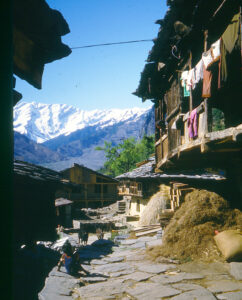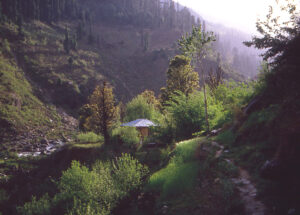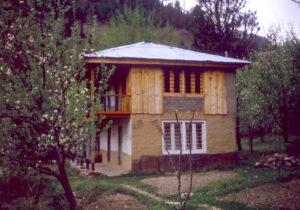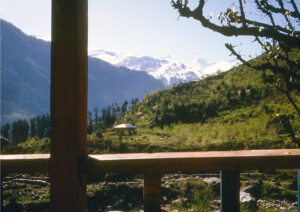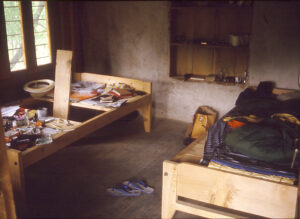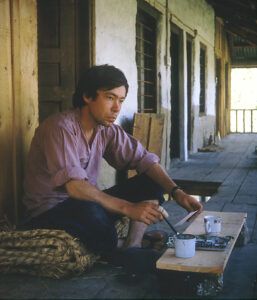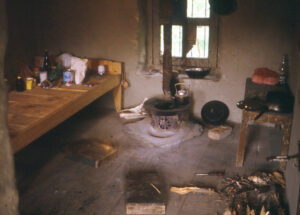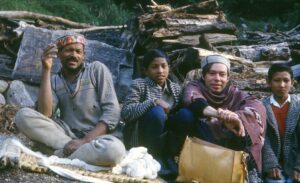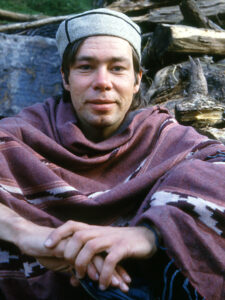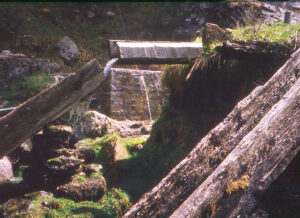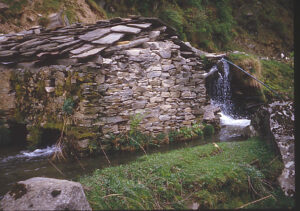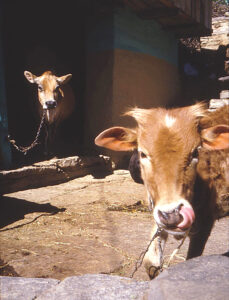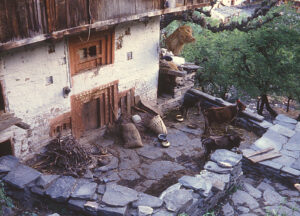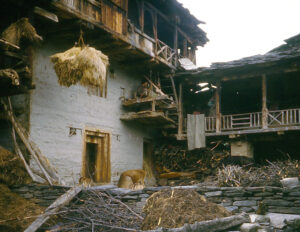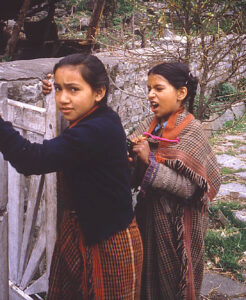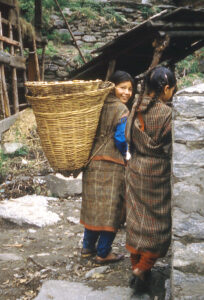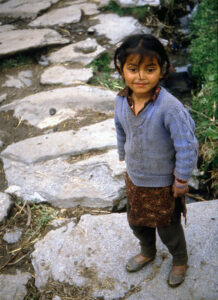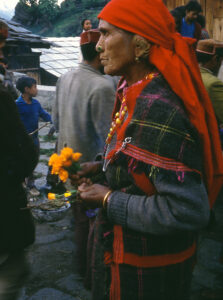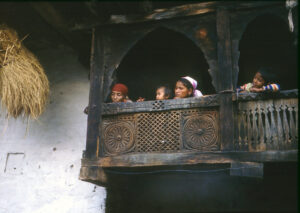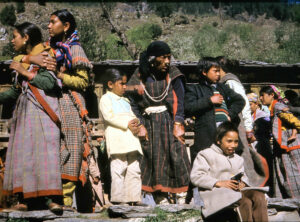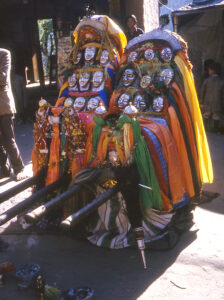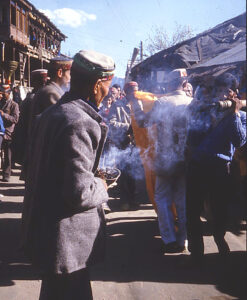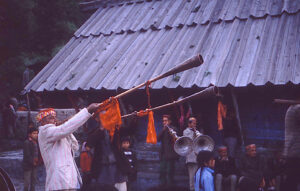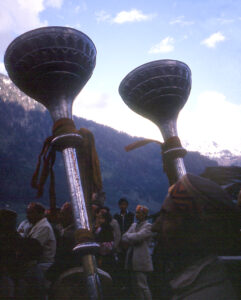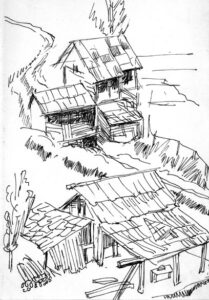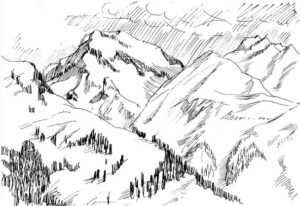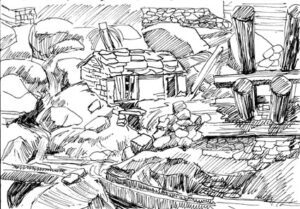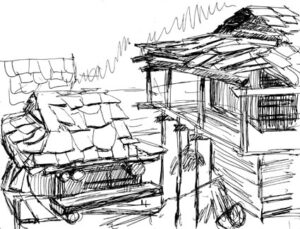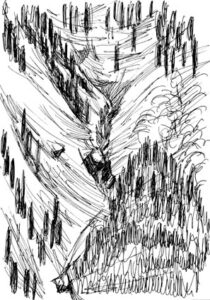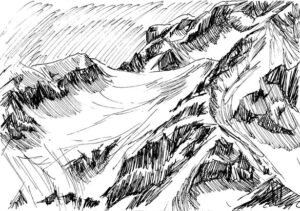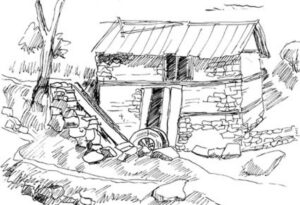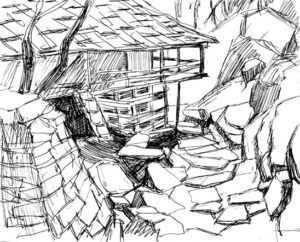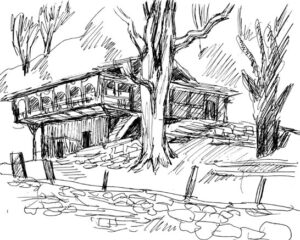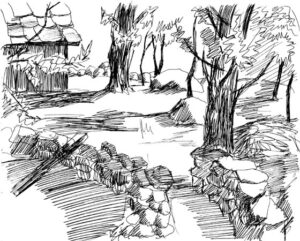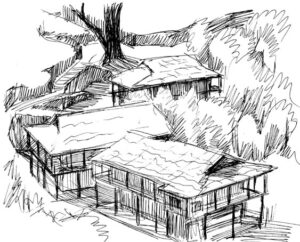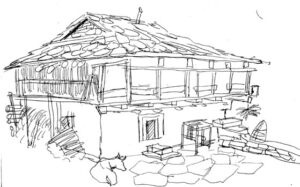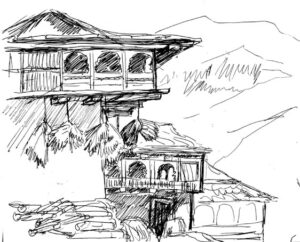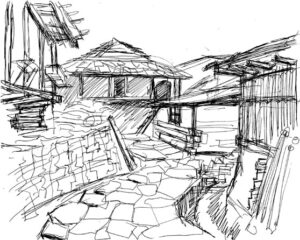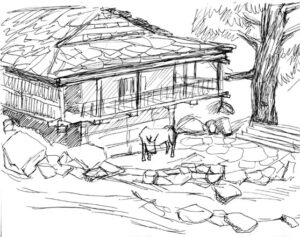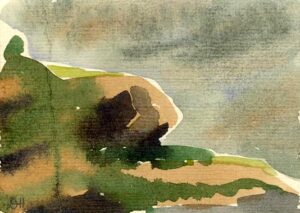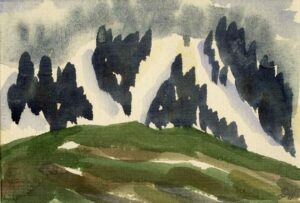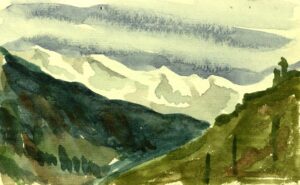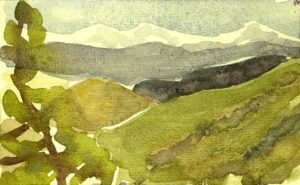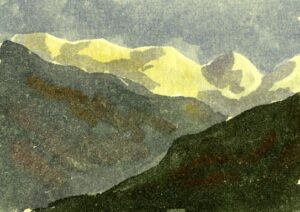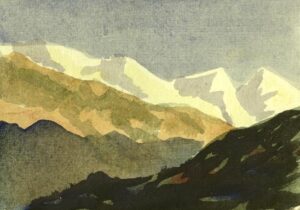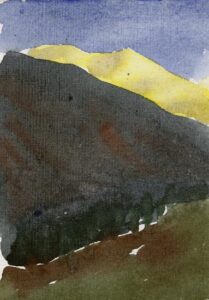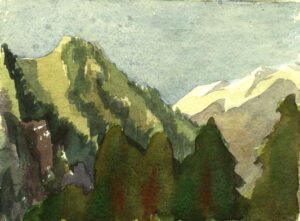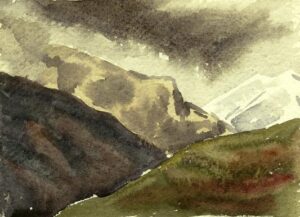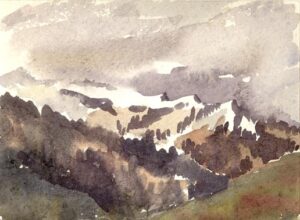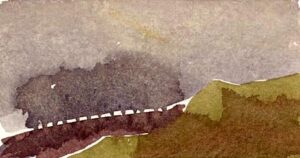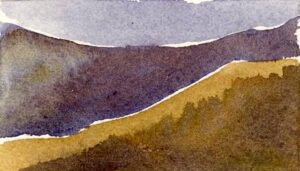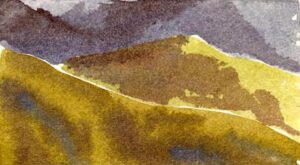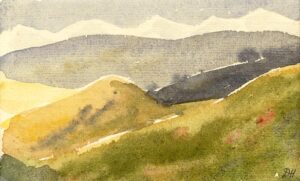Manali 1987

Himachal Pradesh Indien
From the diary 12 April 1987 Kullu Valley India
”Manali. I’m going to live really primitively up in the mountains, 20$ for the whole month for two rooms, one for sleeping and one as a kitchen with a wood stove. Water is taken from the waterfall outside. Wonder how the hygiene, toilet and washing will be? Surely a new experience. The surroundings are really mediaeval. Really interesting mountains, rapids and the cabin is well protected from the winds and the sun shines here in the morning. Plenty of westerners here to talk to so it won’t be lonely.”
Thus began the diary I wrote during my stay in Manali. I wrote something almost every day. Possibly the writing, watercolour painting and drawing together with the photography became the diary that makes me remember the time so intensely. Remembering almost every step, event and view, meetings with the people of the village, their parties and musical events. The hikes through the mountains with the snow mountains in the background. The road towards the Rohtang pass over to Lahaul and Spiti became a dream, I stayed in Manali, it was good to be here.
Earlier, after a few days in Simla I was on my way through Kullu valley by bus to Manali at the highest point of the valley before the peaks and passes took hold leading beyond the himalayas to the trans himalayas. The meandering valley with the river Beas at the bottom was constantly visible from the bus window and the ever-rising mountains into the massif. We rolled past villages with livestock and orchards, steep pastures and terraces.
I arrived in Manali late in the evening and checked into a cheap hotel along with some other westerners who had been travelling companions.
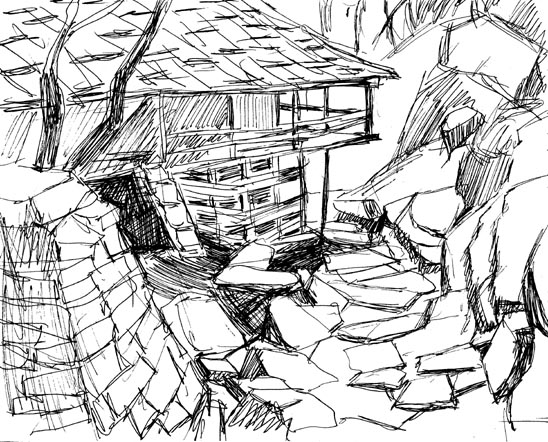
The air was fresh and clear the next morning, a little chilly before the sun had time to find its way down into the valley. The big onslaught of Indian tourists would come only in May/June. There were sections of forest close to the community to walk through up towards the old Manali which was further up the mountain. First I crossed a tributary of the Beas and stopped for a cup of tea in a simple roadside shed. There I could look out over the apple orchards that were in bloom. It was the English/Americans who introduced apple farming in the valley and which has since been a good business for the local population. Apples are one of the most popular fruits in North India despite not being the cheapest fruit. Up the tributary I saw some houses that didn’t seem inhabited and then found out they were available for rent. The tea shed was a link between the tourists and the people of Old Manali who owned the houses. I later arranged a meeting with one of the house owners. The way up to the cabin was a path with steep steps and narrow ledges towards the edge of the mountain where you looked down into the roaring and swirling rapids. The eldest son in the family showed me a house beautifully situated between the apricot trees on a slope down towards the rapids.
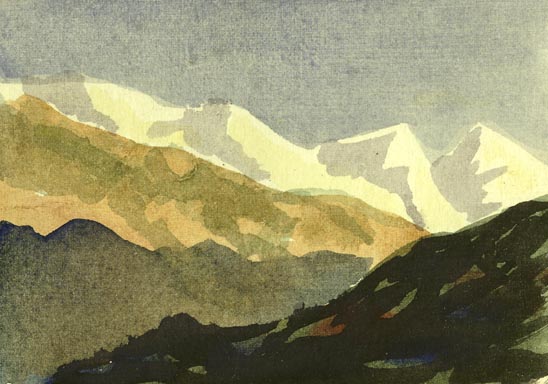
Manali April 13
A beautiful alpine area. Tall forests, rapids, fruit trees everywhere, mostly apple trees in full bloom. Old Manali is like a medieval village. The houses are two-storey with loft corridors all around and animal stables down there. Straw bundles hang to dry from the loft corridors. The women sit at the looms on special balconies. The children are very cute. Some carry around their little siblings in a simple fabric sling. The roofs are stone covered, flat stones, not slate stone which was so common in many places in the mountains. The frame of the house is made of stone and logs while the other parts are made of wood, dark beautifully carved wood. Doors and window jambs are decorated. Beautifully woven fabrics in various patterns and colours hang from the loft railings. The men wear the ”kullucap”, a round cap with a colourful border, all in wool. The sheep and goats graze on the green slopes, guarded by shepherds and dogs.
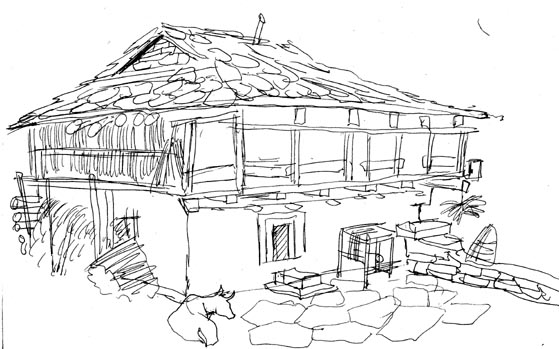
I have moved into a house near the rapids, some distance from Manali. Some French people live on the ground floor. Water is fetched from the rapids and the stove is fired with wood. Primitive but also a challenge. The rapids are loud, you can hear them all the way into the house.
I was down in the bazaar stocking up, and also bought all the kitchen equipment. Will stay very cheap despite this. Fire with wood was an ordeal but I’m learning better as I go. The wood is a little wet and the smoke is troublesome. Sleeping next to the kitchen in a room with two windows from which you can look out over the valley with the fruit trees.
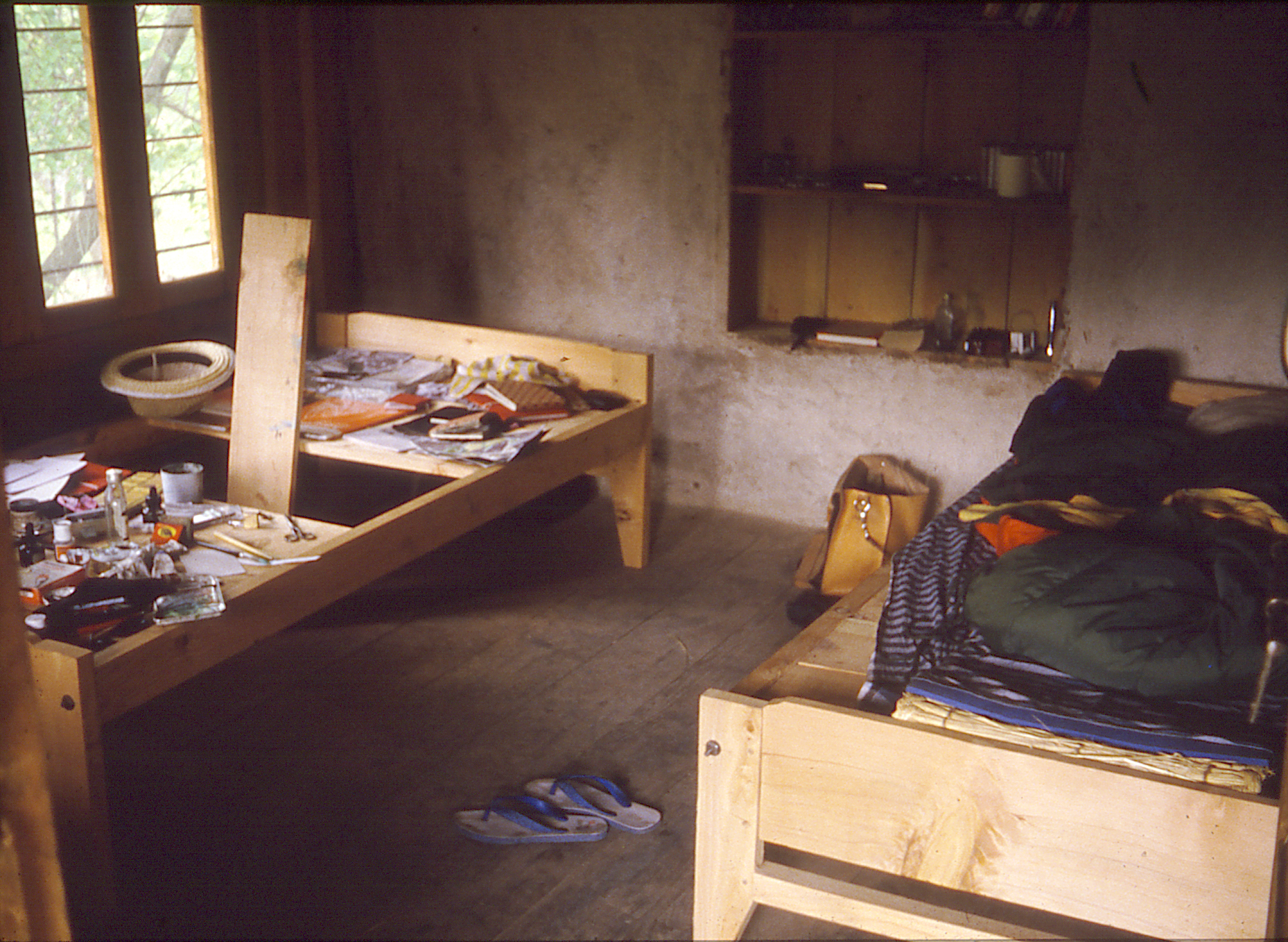
I will definitely enjoy it here after learning the art of hygiene, toilet and dishes. Retrieving water at the rapids can become a strength training. There are plenty of Westerners to talk to and lot of things to work with. Hopefully the weather will be nice.
A wonderful full moon the first night, cold but good to have a warm down sleeping bag.
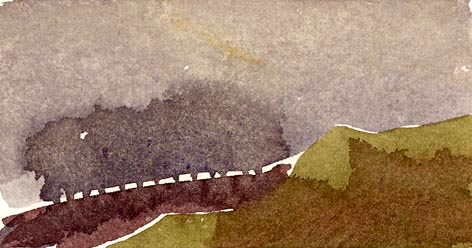
The water in the rapids was ice-cold glacier water. Builded up the courage once and stood in a still puddle and poured water over me. Only did it once. There had to be heated water and washcloths instead of a shower in the rapids. The toilet was a ramshackle shed outside the house that barely provided any protection from view, a hole between some boards and a latrine barrel. I boiled the water in the rapids before drinking it, you never know how many such outhouses there were upstream. However, never got loose in the stomach, got the opposite problem with a hard stomach from all the lime in the water.
Manali April 14
There’s a lot of hash here, it’s cheap and the cannabis grows wild on the slopes, even outside my house. Many are here only for the drugs. You see tragic cases, broken souls. Locals do not suffer from any addiction of their own. Most people have probably tried it. Many people loathe the whole trade according to the houseowner. Apart from the house, he helps on the family farm with apple orchards, but is above all a popular guide for Westerners who want to hike in the mountains.
A man and two women from France who live below me smoked a lot of hash in the evenings and the sweet smell penetrated upstairs. They had their kitchen out in the open under a tree in front of the house. Greeted them every morning from the loft corridor. As long as they paid the rent and didn’t cause trouble, the police didn’t make any raids. The cannabis was grown in some places to extract fibers that were made into hemp rope. The top leaves and flower buds were kneaded into a dark dough and sold as hash or charas as it is called here. Flower buds and leaves were also dried and sold as marijuana, ganja. The hash dough was crumbled into regular tobacco and then rolled into cigarettes. Marijuana is smoked in pipes. Local people used it in their festivities and religious functions. Ganja was sprinkled on the incenses as an offering to Shiva, one of the gods who used the drug.
Manali April 15
Another fine day. A lot of time is spent on the simple chores, cooking, washing dishes and washing oneself. Everything takes time when you have a wood stove and the rapids as the only source of water. Need of a bigger sink, it makes washing up easier.

Wonderful to sit in the sun, look over the mountains, hear the rushing of the rapids. The apple trees are fragrant in their bloom, the greenery is sheer. The people live close to nature with ancient traditions.
Manali 17/4
Visited old Manali and started drawing the medieval old houses. They are architectural masterpieces when you start analyzing the construction. The heavy stone-covered roofs, the loft passages, the stairs. The foundation of stone and the superstructure in logs, stones and wood. The beautiful stone-paved yard where the cows keep their calves. The women brought their loads of wood from the fields. Even on a daily basis, they were beautifully dressed, woolen clothes they wove themselves with colorful patterned borders. Many live on orchards and the handicraft of woolen weaving, kullucaps, shawls and sweaters are sold in the bazaar. The men do much of the farming, looking after the sheep, build the houses and the terraces. The women sit and weave in looms on specially built balconies from the houses.
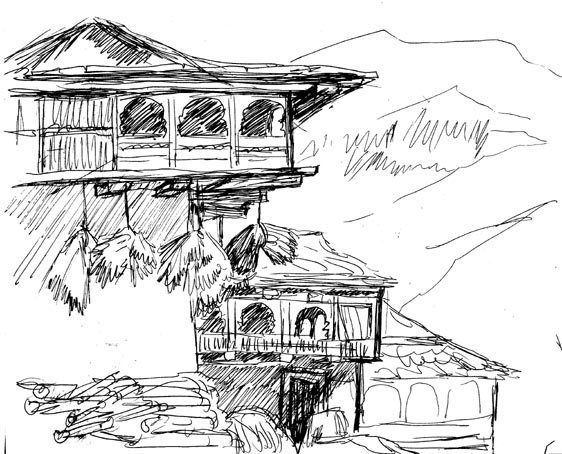
In the afternoon I went to Vashist, a village on the other side of the valley where they celebrated their special village god. The village was in a festive mood. The men wore their finest hats and the women their richly embroidered and colorfully woven folk costumes.
There is a special people here, the face is oblong with a beautifully curved nose and the complexion is very fair, there is a certain mixture with the Tibetan peoples.
The village god was taken out of the well-carved little temple to the sound of drums and trumpets. Bells rang and incense burned, trumpets blew, straight and long or in s-curves. The god was carried around in a litter by two men. They must carry it all the way to a neighboring village for greetings. Maybe the local god there can give his blessing or is it more a sign of friendship? Pakoras and sweets were sold everywhere along with tea.
Manali 21/4
The days go by. Today the French and the women in the floor below me left for the bus ride to Delhi. The man in the party was going to France and earn at least 3 million from his smuggled hashish/marijuana. I didn’t find out how he did it. The money would go to a motorcycle safari across Africa. The women were going to Calcutta and work with the Mother Therese movement in the slums, a contrast indeed! They seemed to have plenty of money, very young, maybe with rich parents?
I stayed in the loft all day, washed clothes, wrote letters, painted the view.
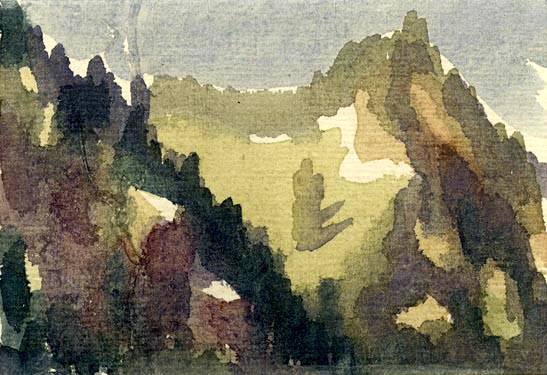
Talked to the home owner’s son, the second oldest. He told me that there had been weddings in the village for three days at a cost of at least 25,000 Rupees (6000 Kr, which is a well-paid annual salary). Tonight the couple would be together in the wedding bed. The conversation turned to sex. He was not interested in marriage, he rather bought himself a girl in the village for one night. Divorces also occurred, he said. The wedding in the village was between two villagers, so they knew each other from childhood, they were 17 years old. Sex before marriage was not allowed according to the religion. I said that the same rules applied in Europe but few followed them because the law was not against free sex except in cases with minors. We talked more about sex, more than would be appropriate to reproduce here…
Manali 22/4
The water-powered mills are built entirely of stone and wood. From a height of approx. 2 meters, the water falls in a chute down to the paddles, where the movement is then switched over to horizontally spinning mill wheels. The grain is ground very slowly. The mills are small, it is not possible to stand upright inside. Got a bag of flour that was perfect for baking chapati with, a very good wholemeal flour.
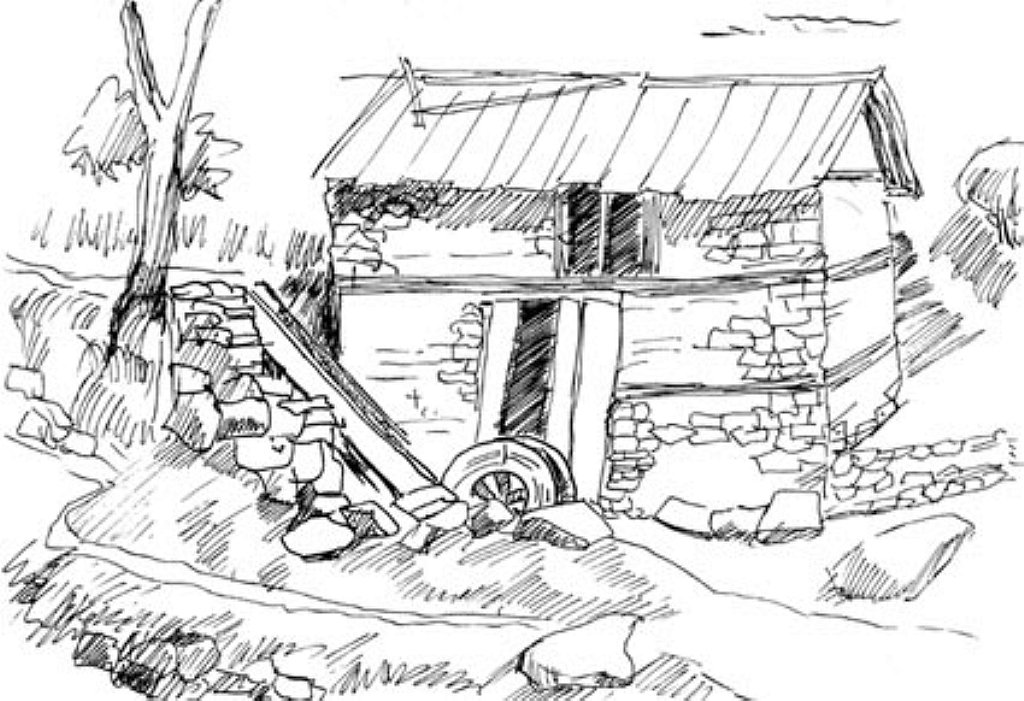
Also found a sawmill that once was water powered. Now the power had been replaced by electricity
Any rapid with waterfall of sufficient height could power small mini-electric power plants of a few kilowatts. It would be enough for several families’ electric lighting or provide a family with energy for both cooking, TV, radio and lighting. Valuable forest could then be saved.
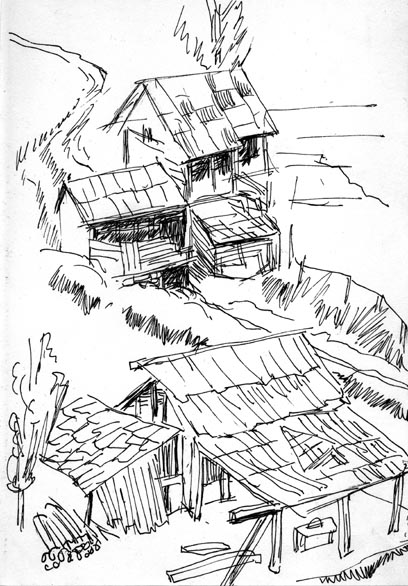
Met a farmer who sold a special substrate from rock stones (rock gum) that helped with all sorts of diseases, impotence and digestive problems etc. A black resin that was sought after. He also traded in other countries and had been to Pakistan, Malaysia and Nepal. He gave a well-to-do impression.
23/4 Manali
Rain all day, the thunder rumbles, the lightning flashes. The green gets a lovely glow, the stones turn blue. Painting the view, it is easier to see in the cloudy weather, the sun strains the eye, makes everything much more difficult.
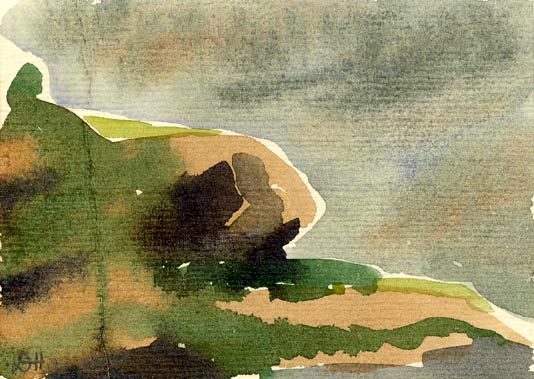
Talked to the the head of the family who own the house. A simple and straightforward person, something that the older brother had inherited. Explaining the economy in the West was difficult. The weather, the snow, the length of the days, the house building, the forestry, etc, went easier.
Here they don’t have much work for six months. They sit in their huts, spin and weave, feed the animals. They got to save from the summer’s activities, collect in the barns, from the apple orchards, agriculture and sheep farming.
27/4 Been sick for a day, got something bad in my stomach and felt nauseous. Just to lie down and recover, healthy the next day, full of energy.
I made the first long hike up into the mountains. Followed a path through dense forest, tall thick conifers, chestnut trees and oak. Bumped into an old sheep herder who absolutely wanted to try my straw hat, he almost disappeared into it. His own Kullu cap was neat with some wilting wildflowers. The sunglasses would also be tested. He laughed heartily and showed the sparse palate. A young boy was also in the party. Further up the mountain we met an English girl who was in Manali for a few days before going back home. She had worked in Australia. We took a break. Her glasses were also interesting, as were her shoes and backpack. How many sheep did he have in the flock? Around 100 pcs. They were cut 3 times a year. At 5 o’clock they would be driven back home.
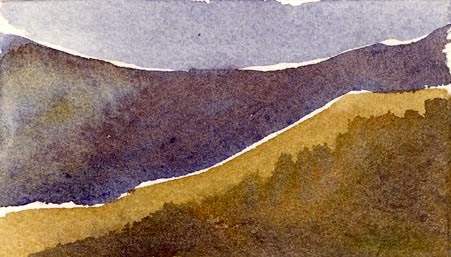
The English girl continued with me up, past a steep rapid where there was still some snow. We Came to a clearing in the forest, beautiful green. The chestnut trees had funny flapped bark, like trees in storybooks, dressed in fringed clothes. Large boulders were scattered in the clearing with a beautiful view of the snowy mountains. An old man with his young helper came down from the forest. They were mushroom pickers. In some bags they had precious mushrooms for health food stores, 60$/Kg in dried form. They also had morels and I bought a big bag for 20Rs The old man spoke good English and traveled to Delhi every year to sell the mushrooms. Here, too, glasses would be tested and studied. I kept walking. The girl wanted to stay in the clearing and study the flora.
Hiked upwards, the path became very steep. A fierce rapid was crossed with exciting rock and wood formations in the surroundings.
At a hewn clearing I stopped, would not see much more of the mountains if I continued. I made drawing of trees, rocks and snow mountains. Slowly I turned back. At sunset, the opposite mountains gained greater relief. The film in the camera had unfortunately run out.
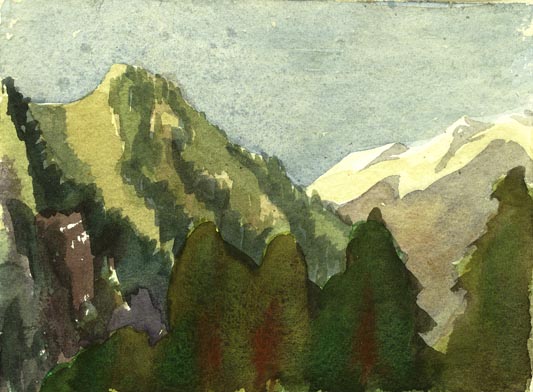
During the evening I cooked a mushroom omelette and hoped for the best for my stomach. It was good, very good and my stomach felt good.
Two Englishmen came here the next day. Very pleasant. They had studied Buddhism in South India. They were only to stay two weeks and then return to England.
Manali May 1
It’s raining and cold. No morning sun to warm up. 1th May celebration here passed by without a trace. If I had met Swedes, they might have celebrated. My stomach is getting better. Bought laxatives and start with wholemeal porridge for breakfast. Been feeling sick for a few days. Was able to work a little yesterday but has otherwise been in bed. I have a little more than a week left of my stay here. There are several hikes left to do. Close to nature and the elements. Making a living here, however, means hard work and poor earnings. However, development in the valley has progressed steadily. Nowadays, all children go to school. People have new occupations and are more financially minded. Tourism, orchards and wool trade are the basic industries. There is very little industry. The Tibetans deal in contraband, their stalls are full of foreign goods.
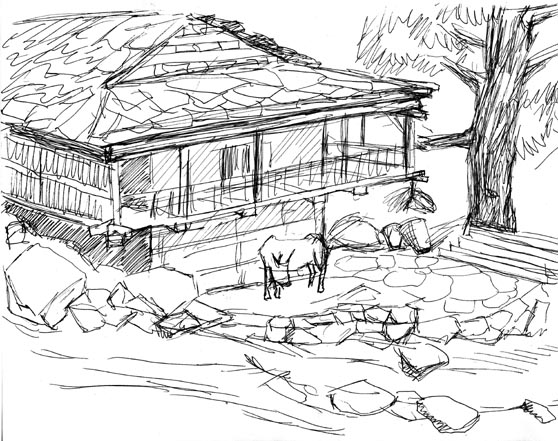
Manali 5th May
Few days left in Manali. Reading an exciting book about prehistoric people ”The Clan of the Cave Bear”. The nature around is like a perfect illustration. I make drawing and paintings sporadically. The stomach is better but the problems remain. The diet and water must have a negative impact. Picked mint and made good tea from it. It hardly helped the stomach to feel better.
Up in the village yesterday I saw a God festival. Drums, horns, incense and flower offerings to the God, carried around by two men. After complicated ceremonies around the temple, the god was carried to different homes in the village. The women were most eager to offer sacrifices, money, incense and silk shawls. There was a constant drumming the whole time. I photographed and recorded the sounds.
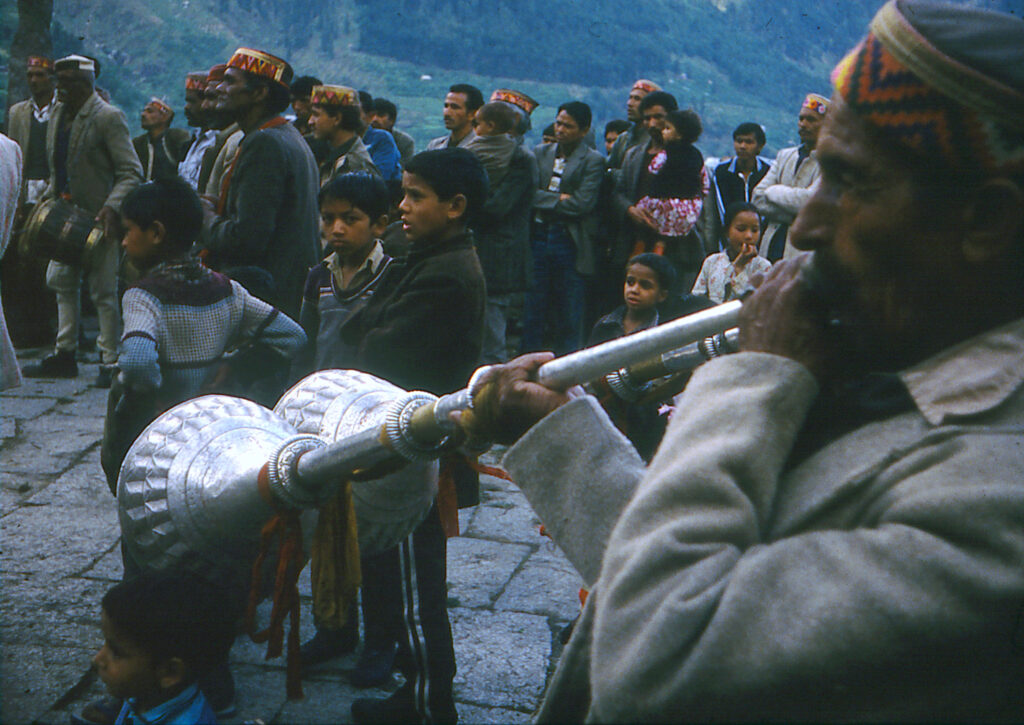
I photographed the house owner with some of the familymembers in front of their home. I also got some pictures of myself shot by the eldest son. He usually disappears trekking in the mountains with the tourists, usually for 20 days. His younger brother is 20 years old and more childish.
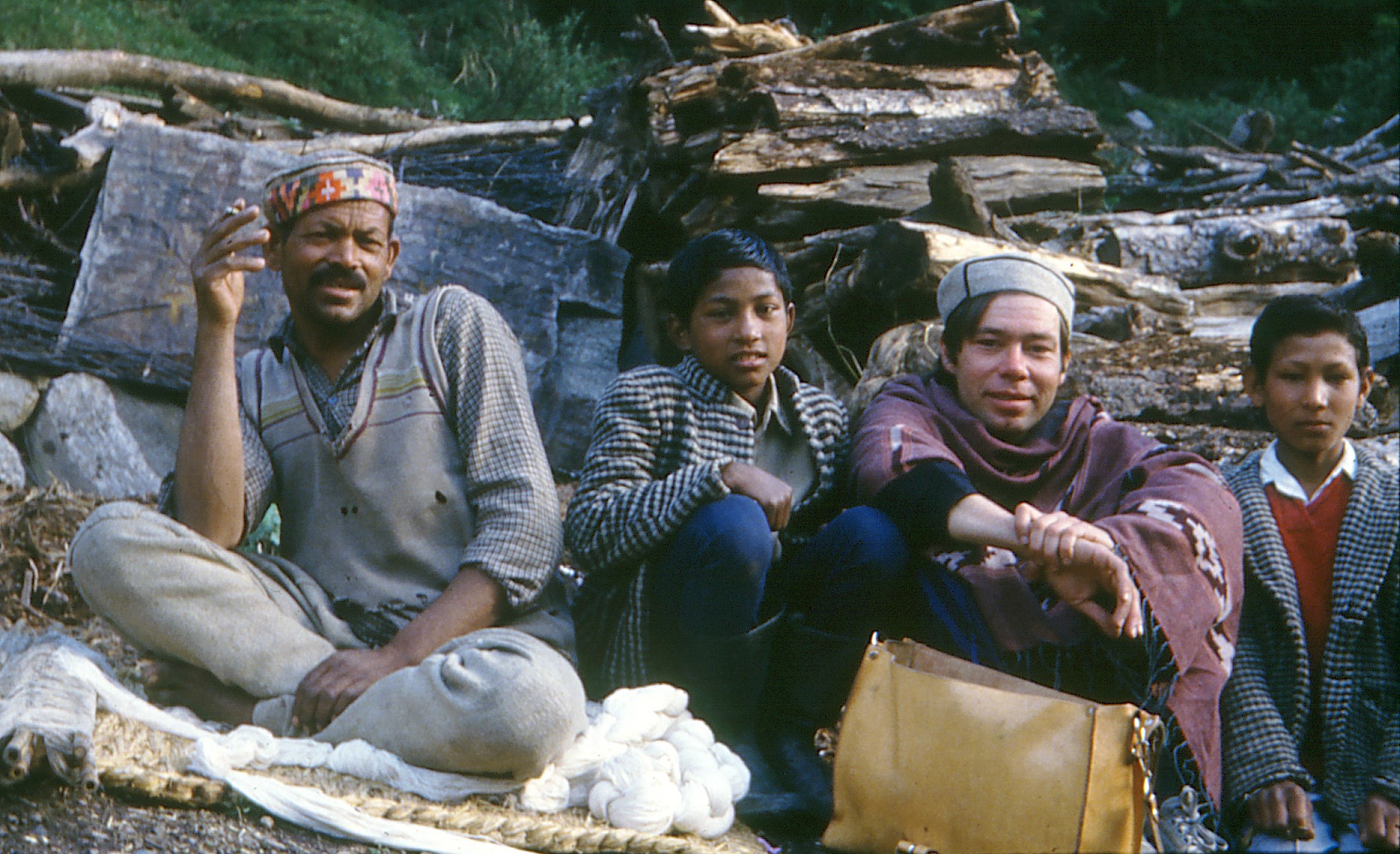
It is a quiet time here, vegetating, thinking, all kinds of chores like cooking, washing dishes, washing oneself and clothes, shopping in the bazaar. It will be nice to hit the road, again, see new places.
Manali 7 May
A lot of rain and the time is passed with a lot of reading.
I partied with the second oldest brother one night. It was on his advice. I cooked a good lamb curry and he brought a bottle of rice brandy. This will cure your stomach he said. Very true, the strong food and brandy dissolved the stomach completely and the next day I had good results on the toilet. I’m will buy rice brandy as medicine for my stomach. It is also a good bed stopper. We were very talkative and excited by the wine at first, but after a few glasses we completely passed out.
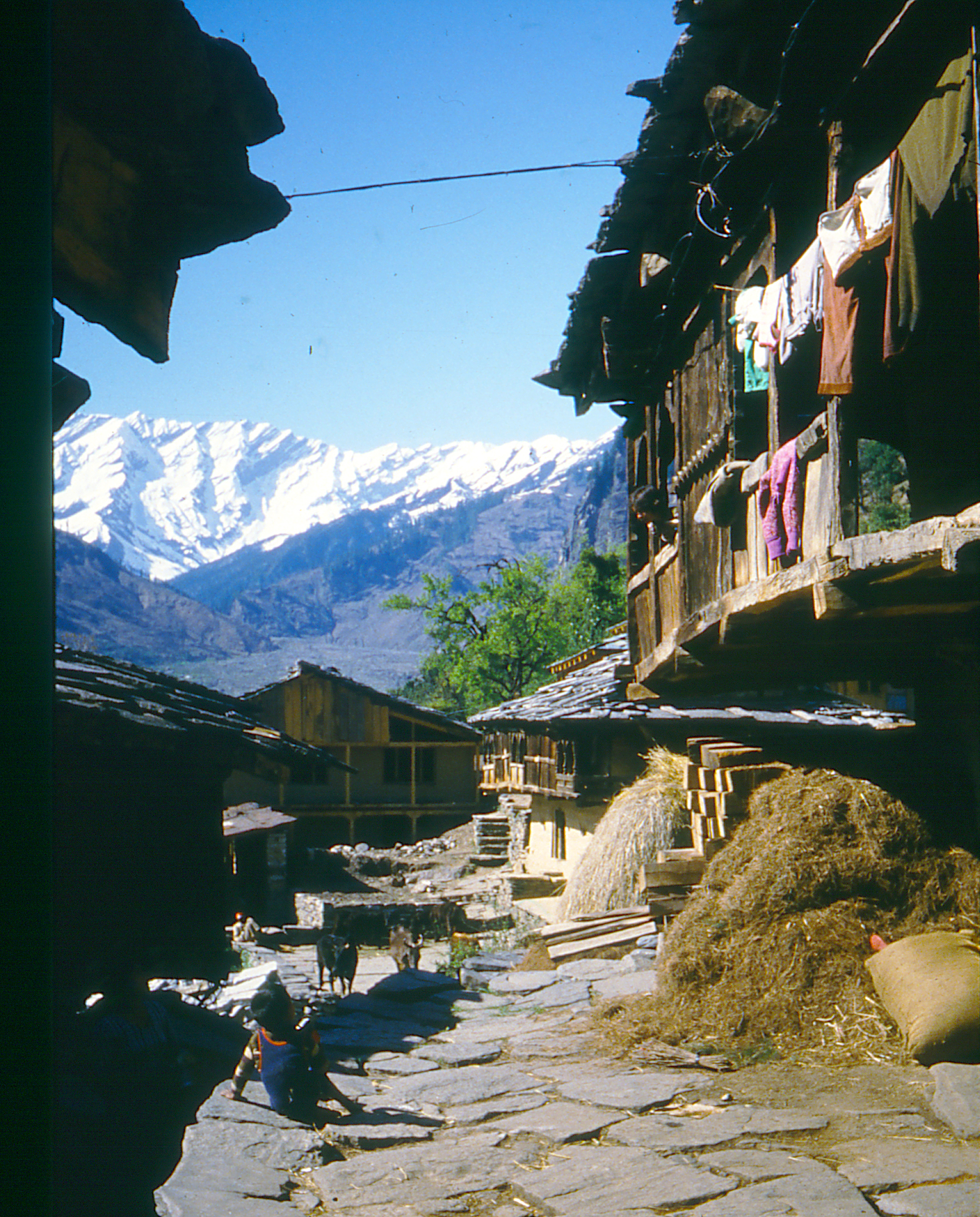
Some exciting new guests are coming here. One is a French musician specializing in the sitar. He has already studied for 4 years and will stay for a few more years. His girlfriend is an artist, she will arrive in a few days. You can get a student visa and through a scholarship apply to university and get a longer residence permit. Maybe something for my next period in India? Chanteniketan in Calcutta perhaps. Varanasi or Baroda with the very finest art schools would be something.
The weather must be nice tomorrow so you can do some excursions.
There ended my diary for Manali and Kullu Valley in 1987. The journey then went to Daramsala and McLoud Ganj, the exile capital of the Tibetans with the seat of the Dalai Lama and large refugee communities plus a large collection of freaks and all sorts of fortune seekers. I then continued to the scenic Dalhousi with dense oak forest and deodars at 2000m altitude. The cicadas played intensely in the twilight. There were old English colonial houses and lots of Tibetan refugees. I stayed in a room rented by an old Anglo-Indian lady who painted watercolors outside the house. There was a large military presence in Dalhousi and I happened to run into them when I roamed a little freely into sensitive territory.
Then the exhilarating drive to Chamba into the interior of the Himalayas…
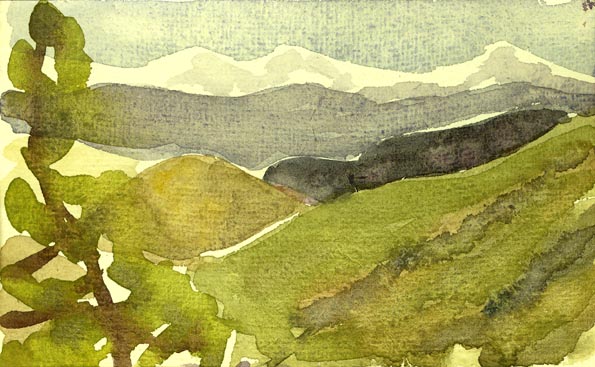
I´m longing to go back, always. The mountains, the roads, the communities and nature. For me there is an intense attraction. This is where I was born and had my most memorable time growing up. Maybe one day in the fall of age I’ll sit painting watercolors outside an English colonial style house overlooking the Himalayas with snow mountains in the distance between the deodars and listening to the cicadas at dusk.
Photographs
Drawings
Watercolours
© Davey Hammarsten
